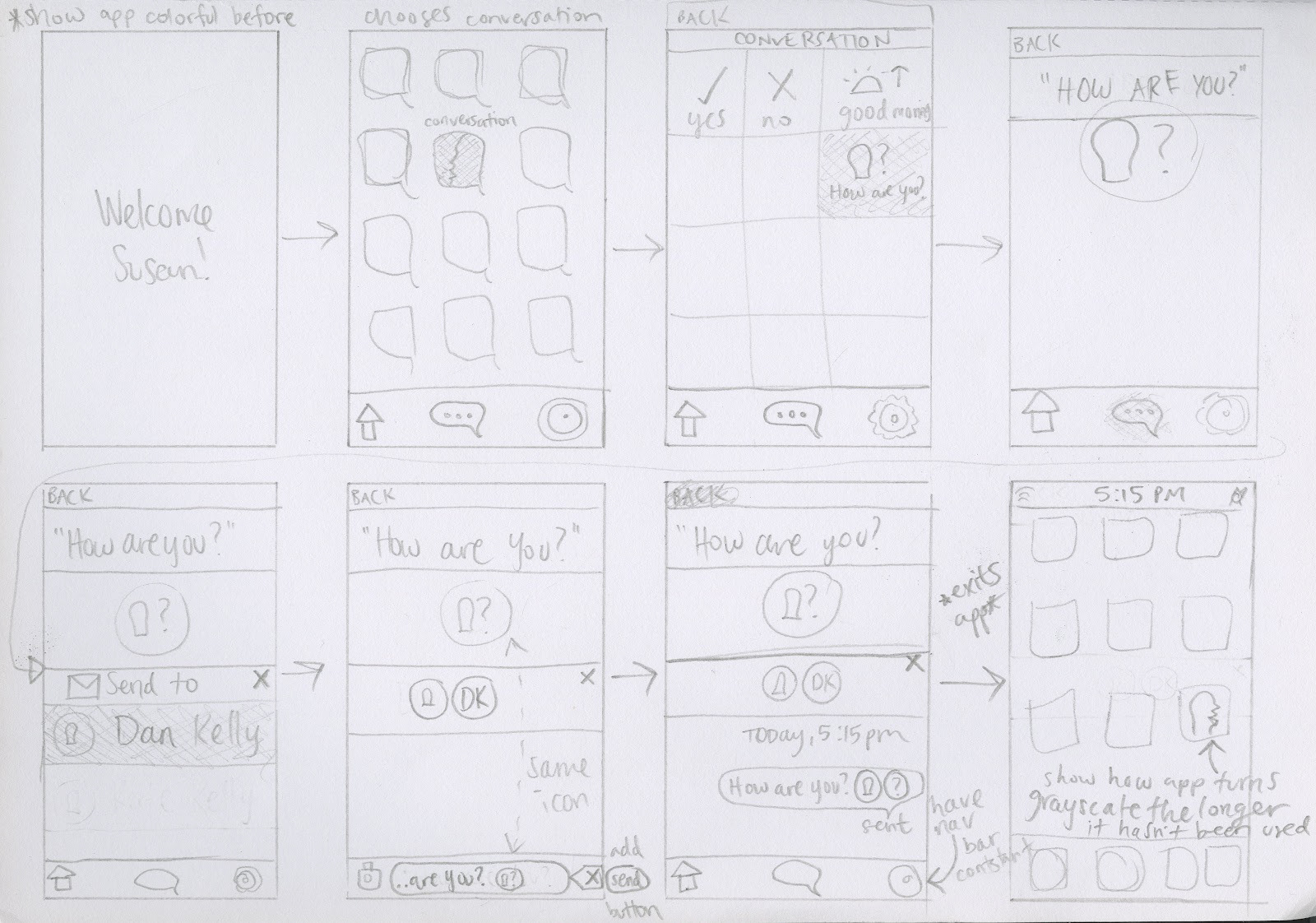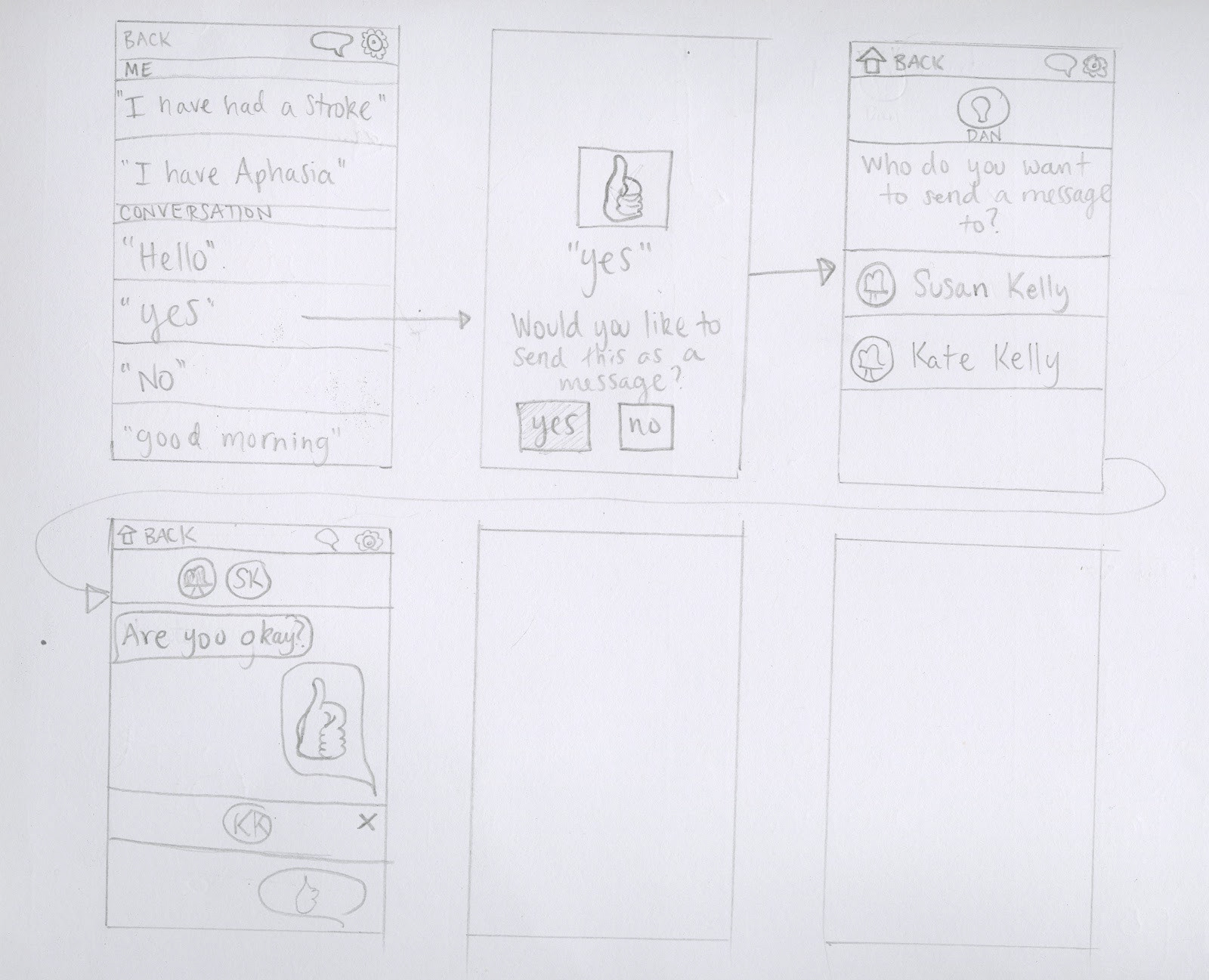Abstract
To explore the issues and design challenges of social and mobile communication systems. The objective is to design an ambient system that allows for two-way communication between two extremely different family members. For our two "extreme" family members, my team chose a father who has recently suffered from a stroke and his perfectly healthy daughter.
Pitch Statement
We want to study the relationship between the user targets (a parent suffering from a stroke and their child) by conducting secondary research in order to create a device to help facilitate communication between the suffering parent and child.
Desired Outcome
Create an ambient mobile communication system that allows for improved two-way communication between a father who has recently suffered from a stroke and his healthy daughter.
Process
Our process consists of four parts:
Part 1: Research. Conduct extensive secondary research on the communication problems faced within a family when a member suffers from a stroke. Also spend time researching common symptoms caused by a stroke.
Part 2: Personas. Frame a problematic situation and develop two extensive personas for each extreme family member.
Part 3: Scenarios. Develop scenarios and storyboards based on these personas that demonstrate a subset of the relevant features and navigation of the system.
Part 4: Brainstorming and Design. Design a system that produces value for both family members and operates at all three levels: interaction, context and system
Objective
Research the effects strokes can have on the individual and their family members. Use this research to develop two personas: a father suffering from stroke and his daughter. Create scenarios and storyboards that demonstrate features of the product solution. Design and prototype a system that improves the communication issue between the two personas.
Part 1: Research
My team and I researched different symptoms strokes can cause—and settled on one called aphasia.
Aphasia Definition: An impairment of language affecting the production or comprehension of speech and the ability to read or write. Aphasia is always due to injury to the brain- most commonly from a stroke, particularly in older individuals.
Some effects aphasia can have on the individual who suffered a stroke:
• Loss of the ability to form words
• Communication limited to sounds or single words
• Reverse yes or no answers
• Repeat single word responses
• Loss of the ability to write due to hampored motor skills unable to articulate written communication.
• Moods shift often and unexpectedly
Communication Issues with the Parent suffering from aphasia:
• Has difficulty communicating with child and other family members
• Has trouble focusing without a visual aid when speaking to child.
• Unable to decipher what the child writes making it hard to assist child through written word.
• Loss of train of thought when speaking to child making it difficult for them to communicate their feelings or desires.
• May be less able to be the parent they were
Effect of Aphasia on child:
• Child may feel neglected and may find it difficult for a parent to be dependent on them.
• Child may worry about the condition of the parent while he/she is gone.
• Can experience anger, frustration, and a sense of loss.
• Might have to act as an interpreter for others
• Has to explain what aphasia is to other family members, friends, those who answer the door, etc.
Sources:
“Aphasia Definitions.” National Aphasia Association, https://www.aphasia.org/.
Edmunds, Amy. “Parenting Young Children After Stroke.” Stroke Connection Magazine.
John. “Communication Problems.” Stroke Association, 5 Apr. 2019, https://www.stroke.org.uk/effects-of-stroke/communication-problems.
“Services: Physical Changes.” Inpatient and Outpatient Services | Memorial Medical Center, 2019, https://www.memorialmedical.com/.
Ann Harlow & Laura L. Murray (2001) Addressing the Needs of Adolescent Children When a Parent Becomes Aphasic: One Family’s Experiences, Topics in Stroke Rehabilitation, 7:4, 46-51, DOI: 10.1310/3V28-6BQ5-CWPG-V3UF
John. “Communication Problems.” Stroke Association, 5 Apr. 2019, https://www.stroke.org.uk/effects-of-stroke/communication-problems.
Meghann Grawburg, Tami Howe, Linda Worrall & Nerina Scarinci (2014) Describing the impact of aphasia on close family members using the ICF framework, Disability and Rehabilitation, 36:14, 1184-1195, DOI: 10.3109/09638288.2013.834984
Part 2: Personas
Based on the research my team conducted above, we framed a problematic situation and developed two fully fleshed out personas:
After creating the personas, my team and I conducted research on some Aphasia communication methods that were currently being used, such as alphabet boards, picture boards and visual aid applications. We found that these products helped to inform our design process.
We found some key ways that these communication boards help people who have suffered from aphasia:
• Visual aids help people with aphasia focus more on the keywords that are being said. This can be more quickly comprehended than a paragraph of text.
• Allow user to communicate using many different forms of media: pictures, sound, words, and gestures.
• Group words, pictures, icons together on a screen to represent meaningful phrases or messages
• Standard questions, responses, yes/no answers, etc.
Product Goals
An ambient app that combines…
• the visual and speech aid of an Aphasia communication board
• the messaging affordance of a texting app.
Goals:
• Minimize the amount of clicks Dan has to do in order to communicate.
• Provide a better way to communicate when Dan and Susan are apart
• Help Dan feel like he can still ‘parent’ despite his condition
• Help Susan feel like she still has a relationship with her father despite his condition
An ambient messaging app that allows both a healthy person and a person suffering from aphasia to communicate with each other on-the-go and in person.
Part 3: Scenarios
My team and I created three key concept scenarios depicting our ideal application being used.
Dan is sitting in on one of Susans soccer games. It’s a close game with both teams battling it out to maintain the lead. Suddenly with 30 seconds left Susan scores the winning goal, giving her team the lead and securing the championship. Dan wants to show his daughter how excited he is so he cues up his Smart Talk app and sends his daughter a string of messages through the simplified interface.
Dan is watching tv and decides he wants to change the channel, however the remote is just out of reach. He sees Susan walking by and wants to ask her to switch the channel since she is much closer to the remote. He is having trouble explaining what channel he wants so he pulls out his ipad and uses the Smart Talk app. He uses the app and its pictagram interface to tell Susan what he wants.
Susan’s Dad is often at home alone when her mom is away on business trips. During the school day, Susan finds herself worrying about how her Dad is doing at home alone. What if something happened to him while she was gone? What if he couldn’t call the police?
She quickly pulls out her Smart Talk App, selects the “How are You?” phrase and sends it to him. She closes the app and goes to her class. After her three classes, she notices that the Smart Talk App launcher icon is more grey and less colorful than it was before. This means that it has been a while since she responded back to her dad. She opens the app and notices a new message that she missed from her Dad during one of her classes. His response was a thumbs up icon. Susan feels relieved that her Dad is okay at home alone and is excited to see him when she gets home from school.
These scenarios helped my team and I to visualize our final product being used by our personas. Considering this, we tweaked aspects of our product before conducting the brainstorming session for our final product.
Part 4: Brainstorming and Final Design Prototype
Goals
• Minimize the amount of clicks Dan has to do in order to communicate.
• Provide a better way to communicate when Dan and Susan are apart.
• Provide visual aids to help Dan focus on the subject of conversation
Features
• Aphasia board feature - similar to traditional physical communication boards
• A social feature - one that can allow dan to communicate with Susan while she is away
• An ambient feature - one that won’t disturb Susan while she’s at school or playing a soccer game
• Allows both a healthy person and a person suffering from aphasia to communicate with each other on-the-go and in person.



Final Design Prototype
The final design prototype my team and I created consists of these features:
• A messaging app with keyboard capabilities that include an aphasia communication board. This includes common phrases, emotions, household objects, and commonly used words that Dan will use to communicate throughout his day. It also includes visual icons that will help Dan focus on the subject of conversation.
• An ambient feature that notifies the user when a message has not been replied to in a while.
This application provides a better way for Dan and Susan to communicate when they are apart.
Workflow of app from Susan's landing screen, to quickly selecting the conversation communication board, to selecting the phrase "How are you?" to put in the sentence builder, to sending the message off to her dad with linked icons.
Look of app with no new messages.
Look of app with one new message and some time has passed since the app has been opened last.